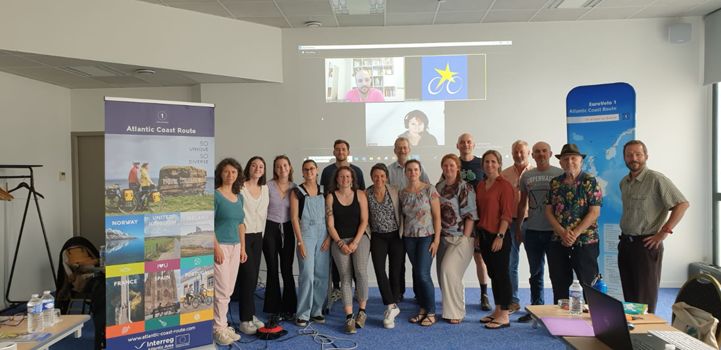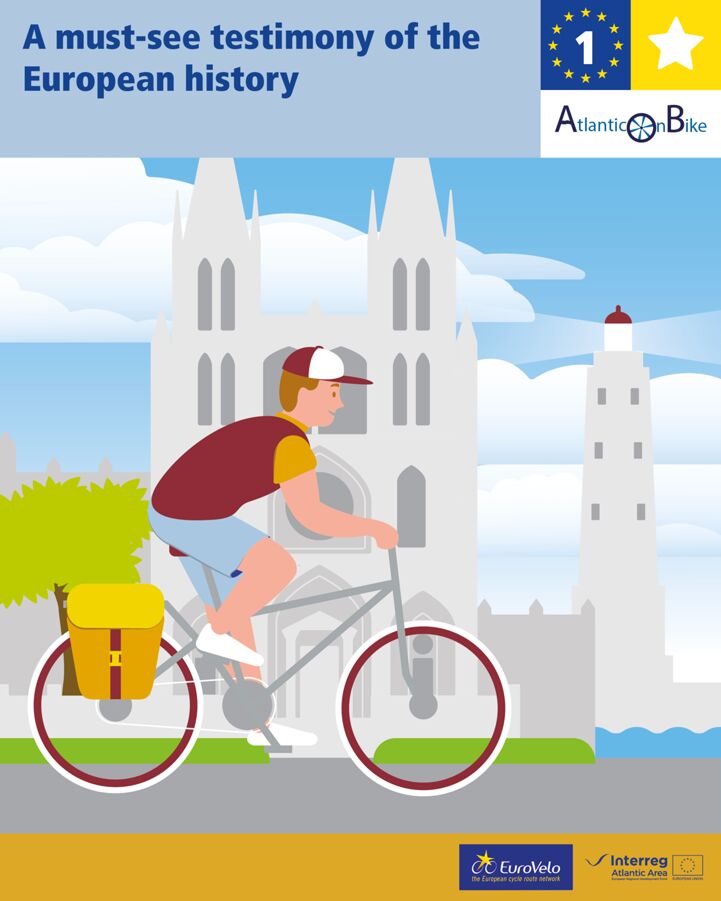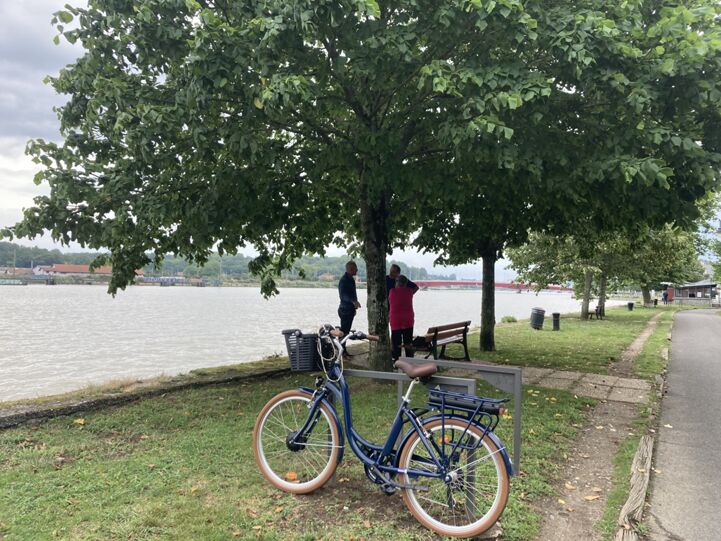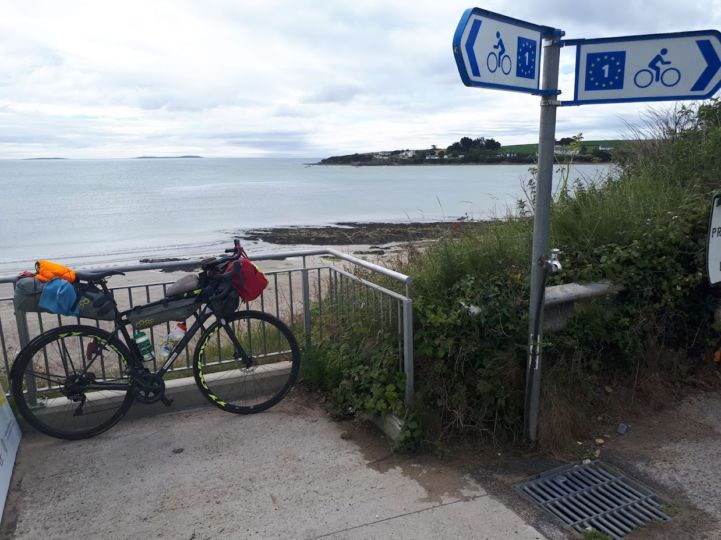Wrapping up the AtlanticOnBike project extension: a productive sixteen months
The original AtlanticOnBike project ran from 2017 to 2020 and involved 21 partners along EuroVelo 1 – Atlantic Coast Route. It achieved numerous results and deliverables and led to the creation of the EuroVelo 1 partnership 2021-2023 (formerly called Long-Term Management Agreement, LTMA) to pursue this fruitful collaboration.
Building upon the work produced in the frame of the original AtlanticOnBike project, this one-and-a-half-year extension brought together a smaller group of partners to make use of the funds in a more efficient manner: Statens vegvesen (Norway), Sustrans (UK), Department of Transport (Ireland), La Vélodyssée (France), Conseil départemental des Pyrénées-Atlantiques (France), Conbici (Spain), FPCUB (Portugal), and ECF, based in Brussels. Unlike the original AtlanticOnBike project, the partnership of the project extension covered the entire length of the route.

The project’s final meeting in Bayonne, France, was the opportunity to share an overview of the deliverables developed throughout the last sixteen months. By some unplanned coincidence, this gathering took place exactly ten years after the first preparation meeting of the original project, in the very same city. Maybe a sign of destiny that heralds continued collaboration in the future.
Before looking ahead, let us stop briefly and look at the project extension’s achievements and congratulate all the partners for their work in nurturing EuroVelo 1 into a thriving long-distance cycle route.
Working towards enhanced communications

Communications and marketing are key to developing a successful tourist product. Therefore, many activities aiming at strengthening the Atlantic Coast Route brand and improving its overall coherence took place, including improvements to national websites and the production of promotional material (photos and infographics).
A Transnational Marketing Strategy was drawn up based on the extensive diagnosis strategy formulated in the original AtlanticOnBike project. This shorter document summarises the main outputs of the strategy to make it easier to use by the partners on a day-to-day basis. It can be found on the Resources page.
Last but not least, a great promotional tool was developed in the framework of this project to inspire future cycling holidays along EuroVelo routes, the EuroVelo Route Planner. This exciting new feature covers the whole EuroVelo network and allows you to plan the cycling itinerary of your dreams adapted to your preferences thanks to customisable settings (most developed itinerary, most direct or least climbs). We explain all functionalities of the route planner in this article, including a tutorial video.
Improving the quality and safety of route infrastructure
In order to create an attractive tourist product, route infrastructure must be high-quality and cycling-friendly services should be regularly available. Information about the route must also be readily available online and along the itinerary. This is why the project focused on identifying issues and improving route sections: in particular, the work consisted of mapping route continuity, surfaces, safety of sections shared with motorised traffic, accessibility, signposting, access to public transport, accommodation, water, food and bicycle repair.

A new route survey was organised in Portugal, using the European Certification Standard methodology. In Ireland and Spain, simplified surveys were conducted to check the improvements made along sections surveyed in the framework of the original AtlanticOnBike project, while in the UK, Sustrans verified the route signposting and the sections already equipped with EuroVelo route information panels. The Norwegian stretch of the route is too long to be surveyed by bicycle, but information on the safety of roads and tunnels was gathered. Ireland, France and Spain updated the pre-existing national action plans from the original AtlanticOnBike project, adding new priorities with 2030 as a target. In the UK, improvements to EuroVelo 1 – Atlantic Coast Route will take place in the framework of the wider National Cycle Network’s development plans, led by Sustrans.
Contributions from all countries were then analysed and regrouped in a new Transnational Route Evaluation Report and Action Plan, with the aim to provide an overview of route quality in each country, highlight the main critical issues, and underline the priorities for new measures and route improvements in the short, medium and long term. Such document is also a useful tool to advocate for more investments on the route.
Networking at heart
It is essential to raise awareness of EuroVelo 1 among all stakeholders involved in cycling tourism. To this end, a number of national workshops were held to inform local decision-makers, tour operators, public transport providers, etc., on many aspects of the route, facilitate networking between different participants involved in the sector and foster public-private partnerships.
ECF also created a Toolkit for the Development of Transnational Cycling Products to help the partners develop more transnational products and bookable offers on EuroVelo 1 – Atlantic Coast Route.
Sharing knowledge on public transport, services for cyclists and signing
Conbici produced a report gathering information about public transport along EuroVelo 1 in Spain, whereas, in France, cooperation with public transport operators and service providers (tour operators) was reinforced, in particular to develop multimodality and keep on sharing information on the route development. EuroVelo.com was also enriched with general information on multimodal options ensuring continuity between sections and countries when needed (ferries, trains, etc). The Conseil Départemental des Pyrénées Atlantiques also set additional equipment on tourist sites along the route.

Signing is another important aspect of a continuous tourism product. In Portugal, a new handbook for public bodies highlights best practices, while a signing pilot was implemented in the UK, successfully bridging the national cycling route and EuroVelo route signages. New EuroVelo signs were also installed between Tromsø and the North Cape, in Norway.
ECF produced an updated EuroVelo Transnational Signing Manual, building on the first manual published in 2019 in the framework of the original AtlanticOnBike project. It presents the most general principles for signing long-distance cycle routes and the specific requirements for incorporating EuroVelo logos on route panels.
Additionally, the EuroVelo Management Team issued a new Transnational Guidance Document on Rest Areas. It aims at providing partners with the main principles to keep in mind when installing rest areas along cycle routes and gathering best practices across the EuroVelo network, including some of the latest innovations (e.g. charging stations for e-bikes, QR codes on route information panels).
Gaining more insight into the route usage… to better match the cyclists’ needs!
Finally, activities focused on monitoring and analysing route usage, which allow to have a better overview of cycling traffic, its seasonality and its general evolution throughout time. Such analysis is key to evaluate if the actions taken are bearing fruits and driving an increase in usage. It is also essential to demonstrate to decision-makers that investments are needed in route infrastructure and produce tangible effects. Demonstrating the positive economic impact following route development is also a powerful argument to lobby for more funds for cycling infrastructure and promotion.
To this end, the data from more than 100 counters was gathered and analysed in an insightful report produced in collaboration with Eco-Counter, available here. You can read more about the main findings of the EuroVelo 1 - Atlantic Coast Route - Bike counts analysis 2019-2022 in this article.

Interviews and user surveys were also conducted in Portugal, Spain, Ireland and Norway and satisfaction and attendance surveys along La Vélodyssée, the French section of EuroVelo 1. Creative initiatives like the “Cyclists’ Corner” were set up at the North Cape in Norway to collect feedback from users – cyclists were invited to a dedicated space with chairs, table, free coffee, flyers, and a Cyclist Diary where they could leave their thoughts about their experiences. The idea of a Cyclist Diary was taken from a Norwegian tradition, “hyttebok” (Cabin book) and the concept has been a resounding success. These different methods have made it possible to gather essential feedback from cycling tourists, who are the first to experience the quality of the route and identify potential improvements. Knowing their needs is also a preliminary step to guide in the best way future developments.
To go further, the six countries along the route shared insight into the positive impact of EuroVelo 1 on the economy, the environment and tourism. Those national reports were gathered in an Economic, Environmental and Touristic Evaluation Report highlighting the main findings. Among other key figures, we can note that 75% of 14.8 million trips observed along EuroVelo 1 in 2021 were leisure trips in the United Kingdom. Putting a spotlight on the economic benefits of the route, the user survey in Ireland made it possible to estimate the daily expenditure of a cycling tourist along EuroVelo 1 – €73 on average.
These promising results show that EuroVelo 1 has significant potential on many levels, and we can have great ambitions for the future of the longest EuroVelo route of the network with its variety of landscapes and cultural heritage.
ECF thanks all project partners for these impressive achievements and looks forward to continuing the successful collaboration with the renewal of the EuroVelo 1 partnership.


Author(s): Alexandra Fournier, with contributions from Florence Grégoire and Jessica Casagrande